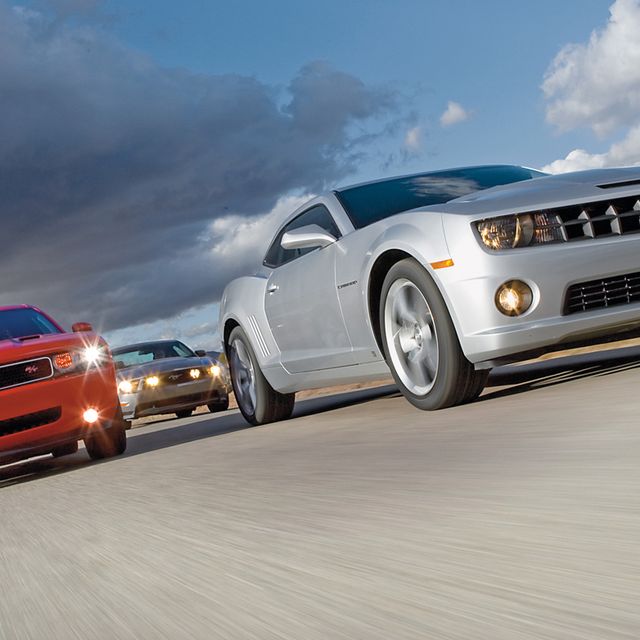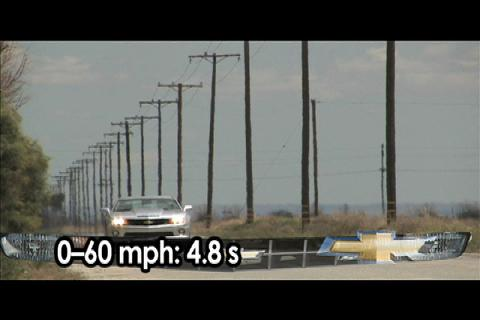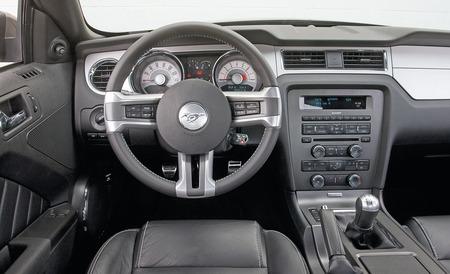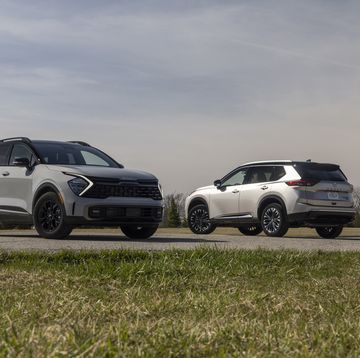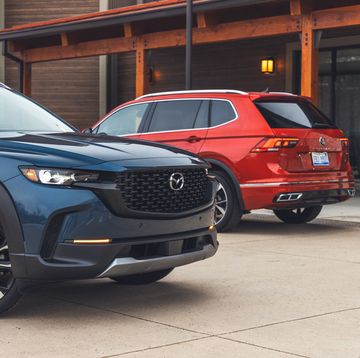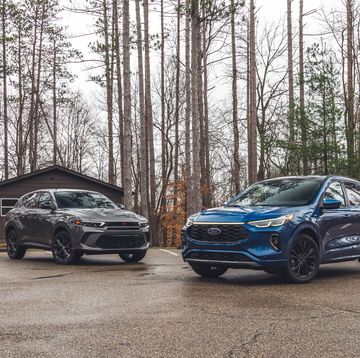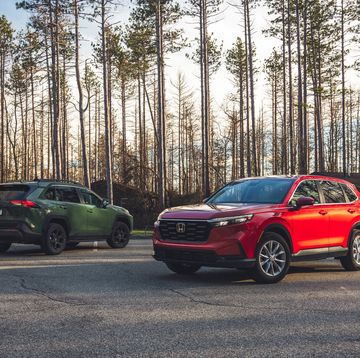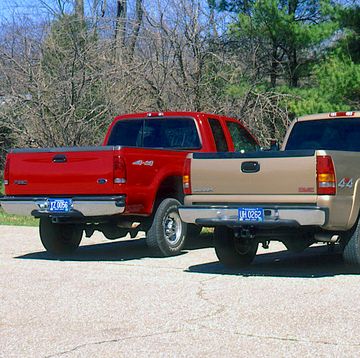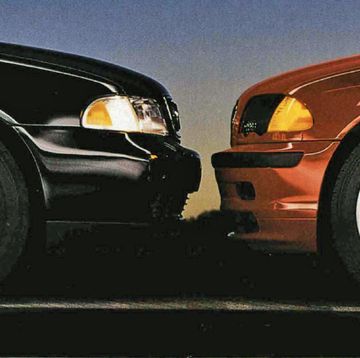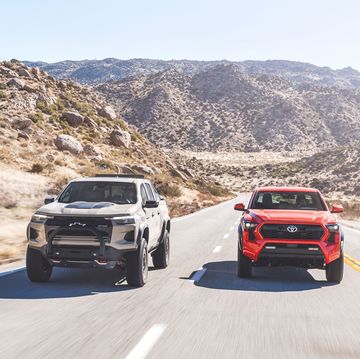If you smoked your draft card or watched the white-suit shuffle from Tranquility Base, you may remember our last V-8 three-way with Chevy, Dodge, and Ford muscle coupes [March 1968]. Who knew then that a rematch would take 40 years? Or that the Earth would tilt so much in the meantime?
Pasadena’s little old lady is in Forest Lawn, and two of the three lords of Detroit are now government-dependent basket cases. You’d be playing long odds to believe this test will ever be repeated. Tune in to the hybrid comparison elsewhere in this issue to see what’s on the White House’s must-have list.
And those all-American, mag-wheeled, sloppy double cheeseburgers we call muscle cars? They’ve gone international, baby. Australians engineered the 2010 Chevrolet Camaro, and Canadians build it, as they do the Dodge Challenger, which circulates Mercedes-Benz blood and comes from a company that, as of this writing, is hoping to merge with Fiat. Ford Mustangs roll down an assembly line with Mazdas.
We waited until we could get all three cars—with V-8s and manuals—in one place. The last previous-generation Camaro stocker we tested, eight years ago, was a shivery live-axle primitive from the Flintstone age. The all-new Camaro is now a bunker-top four-seater—long, low, wide, and draped over the big, independently sprung skeleton of the Holden-based Pontiac G8 sedan. The 426-hp, 6.2-liter LS3 V-8 of the SS, with 20-inch Pirelli P Zero rubber and Brembo brakes—forza Italia!—starts at $31,040. Add the 2SS pack, which includes a Boston Acoustics stereo, Bluetooth connectivity, heated leather seats, and quad console gauges, and the sticker reaches $34,225.
Chrysler put a convex mirror up to its history and produced a two-door RV, a veritable magic bus of nostalgia. The prodigious Challenger is 9.7 inches longer than the relatively peewee Mustang and almost two inches wider, with a trunk big enough for a koi pond. The suspension is also all-independent, the underside derived from the Chrysler 300/Dodge Charger, which was fashioned from the toenail clippings of an older Mercedes-Benz E-class. Seeking price parity with the others, we asked for the mid-level R/T with its 376-hp, 5.7-liter semi-Hemi V-8. That one will follow you home for $30,945. However, this R/T arrived bearing $8675 in options, including a $995 six-speed manual; several leather, stereo, and luxury trim packs; navigation; and chrome-clad wheels.
Unlike the other two, the 2010 Mustang has an unbroken lineage going back to the rocket-age original. Astoundingly, considering the number of redesigns, the solid rear axle remains, protected by a ruthless cost calculus meant to hold the Mustang’s starting price about $1000 to $1200 under those of the Camaro and Challenger. A $1495 Track package is available, with stiffer springs, shocks, and anti-roll bars; very expensive Pirelli P Zero summer tires (again with the Italians); and a digger, 3.73 limited-slip rear end. Add it to the $28,845 GT with its 315-hp, 4.6-liter V-8, along with optional 19-inch machine-polished alloys, heated seats, and an anti-theft pack, and you’re talking $35,425.
The times may be a-changin’, but muscle cars aren’t the province of those who worry about the future beyond the next 1320 feet. The shimmering asphalt of an endless summer awaits.
Quad headlights blazing from the slot. A single bar of wall-to-wall taillights. Hood vents. Chrome wheels with the glint of Cragars. Black stripes that end in the six-inch-high “RT” letters on the hips. Yep, it’s a Challenger, and it stirs up sugary memories like a big orange stick in a cotton-candy machine.
The Challenger is a full-size sedan wearing a coupe costume. Chrysler’s designers did heroic duty scaling up the original Challenger’s shape to fit its big house, but ultimately, it’s a 13/10ths-scale caricature, heavy at the bottom, capturing the essence but not the delicate sexiness of the original.
Muscle cars were always about the slow cruise as much as the fast quarter, and the Challenger is our first draft pick for the boulevard. Four of the graduating class fit comfortably, and every control and motion is cushioned, from the pillow-soft clutch to the six-speed’s featherweight pistol shifter to the mellow suspension that floats over railroad tracks. Wailing at 5700 rpm, the V-8 is loud but barely felt. Only the heavy, vague steering is a burden, and we wish the brake pedal wasn’t quite so swampy.
Nothing flusters this big pleasure craft until the thrashing starts. Then it sways, it bobs, and it squats back and squirms at full throttle like a fat man settling onto a cold toilet seat. Dodge fits the R/T with all-season Goodyear Eagle RS-As, the same tires you might fit to your pastor’s Diplomat. Trying to corral 4140 pounds on a twisty road, they backslide into a decent impersonation of Goodyear’s long-gone Polyglas donuts.
Want to know what the glory years were really like? Find out—safely, thanks to modern anti-crash devices—in the Challenger, where the understeer is relentless, the tail wagging is joyous, and the reason Dodge won’t let you fully disable the electronic stability control becomes patently obvious (only a reduced-interference mode is selectable). One test driver called it the perfect muscle car—if you live in Kansas.
________________________________________________________________
________________________________________________________________
Keep the speeds in saner zones, and the R/T will run down the miles with a relaxed ease not attained by the others. The front buckets are just narrow enough through the torso to provide solid lateral support, the seat travel is long, and the steering telescopes to supply the last bit of personal tailoring.
Sadly, the styling exuberance outside isn’t echoed within. Coal-black plastic is indifferently shaped into something only vaguely sporty. At least it’s functional, with large gauges displaying the vitals, and a touch-screen navigation console is always there for guidance. As in the other cars, the leather pack brings fancy French stitching in contrasting white thread.
At 5.1 seconds to 60 mph, the Challenger is the test slowpoke, although its additional power enables it to match the 560-pound-lighter Mustang in the quarter-mile and outrun it at higher speeds. The Hemi is a late peaker—don’t go looking for any real firepower below 4000 rpm. It pulls out of the hole with a snorty rush in the lower gears, but acceleration pancakes sharply with the upshift to fourth and the start of the tall fuel-economy ratios. In sixth, the velocity delta practically stalls completely, especially on a grade.
It’s true—you can’t go back. But the Challenger has enough retro reverb to prove that you really wouldn’t want to anyway.
Baseball, hot dogs, apple pie, and one sinister-looking new Camaro. Love or hate the styling (some on our panel didn’t exactly love it), credit GM for modernizing, rather than simply mimeographing, its iconic sports coupe.
We’d have preferred a reinvention with more visibility, though. The choptop is pure outlaw, but with 426 horsepower and yards of hiked-up sheetmetal to mind, the Camaro feels like it has less glass than a Nikon. The seats are low, and the dash and doors close in like canyon cliffs, with rear-quarter views pinched by the upswept shoulders and a tsunami of C-pillar. Smallish side mirrors complete the vision jamming.
Because you see so much of the interior, we’re thankful that GM designers committed their best ideas to it: the wing-shaped gauge pods, the deep-dish steering wheel, the unusual waistband of black fabric. The console dials—oil pressure, oil temp, volts, and transmission temp—are welcome, even if they’re down by the floor.
True, our butts eventually grew tired of the hard buckets, and the back seat lacks reasonable headroom, but our fingers never got frustrated working the well-placed radio buttons and the tightly clustered climate controls.
It’s not a Camaro unless it can set fire to a burnout box. Frankly, we expected the 60-mph mark to arrive sooner than 4.8 seconds. That’s only a 10th better than the Mustang, which has 111 fewer horsepower (and is 300 pounds lighter). Still, the Camaro was quicker through the quarter-mile, and our low-miles test car may still have been tight. Even if true, the 6.2 socks it to you in the low and midrange revs much harder than either the peaky Dodge or the Ford. It also drains the tank quicker, returning 14 mpg to the Mustang’s 17. The LS3 makes a muffled, less enthralling grumble than the Mustang.
If not quite the bolter we had expected, the Camaro SS carves nice squiggles, with tamped-down body motions, tacky grip, and a brake pedal so firm and responsive that we checked it for a Porsche part number. We wish Porsche had supplied the steering. Shades of Camaros past are evident in the slightly overboosted and overinsulated wheel. And the pedals are widespread and offset, making fast footwork a challenge for all but the size 14s in the group.
________________________________________________________________
________________________________________________________________
As you can see, this Camaro is more multidimensional than the one-trick quarter-milers that used to wear the badge.
To wit, its story is complicated: The stiff, insulated structure soaks up engine vibes and tire moaning, but the rear end discombobulates and dances while accelerating over rough pavement. The freeway chop-chop, though stiffest in this group, is still tolerably muted, but the clutch takeup is high and abrupt. Palming the Tremec TR6060’s short, precise shifter is satisfying, but the trunk is small and its opening smaller. You don’t load bags so much as push them through a mail slot.
Alas, most of history’s blockbuster cars had faults aplenty.
The panel was shocked, shaken, and staunchly unanimous: This Mustang rules.
Why the low expectations? Look at the stats. Just 315 horsepower. Simple struts up front and a log axle out back. A five-speed pitted against two bolt-action sixes.
But look at the facts: At 3580 pounds, the Mustang is lightest by 300. A lively throttle reels in 60 mph nearly as quickly as the Camaro (the Mustang did have 6700 break-in miles, which may have helped), and the car pulls the highest skidpad g (0.92) by a wide margin. The Ford stops in the same distance as the megabraked Camaro (162 feet), and it returned the best fuel economy (17 mpg) despite having the shortest gear ratios of the three cars.
Explanations? Perhaps it’s because the Mustang stayed in production while the others took long sabbaticals. Ford used the intervening years well. This Mustang is the most beguiling yet.
In this company, the steering trumps—it’s fast, direct, and, though still a bit isolated, far more naturally weighted than that of the other two. Body control with the Track pack is astounding. It doesn’t pogo, doesn’t shimmy, doesn’t slump to the outside and clop its way through a corner. The ride may be firm, but nothing throws it off the slot-like path you cut through turns. And somehow that live axle deals with pitching and pocked pavement with much of the sure-footed poise of an independent setup. A Track-pack Mustang used only at the drag strip is a Mustang wasted.
The Ford is also the right size. It doesn’t devour a driveway or need to be greased into a parking space. The dash and shoulder lines are low, and the 360-degree view out is mostly unhindered. And we admit to being total suckers for the retro, sequential turn indicators.
It’s the shortest and narrowest, with a wheelbase more than five inches shorter than the Camaro’s, yet the interior measurements match or beat the Chevy’s. The back seat, which splits 50/50 and folds (all three cars have folding rear seats, though the Camaro’s don’t split), is adult-usable and even comfortable for riders up to six feet tall.
________________________________________________________________
________________________________________________________________
At the moment, no muscle car sounds more muscular, the “little” 4.6 firing up an 18-ounce center-cut hhrrumpph! of juicy protein. For 2010, Ford installs a “sound induction tube” to pipe more resonant intake noise into the cabin. If that’s all it takes, every vehicle including the neighborhood garbage truck should have one.
As the tach hovered close to 3000 rpm on extended freeway lopes, we longed for the sixth gear offered only in the Shelby GT500. The mind races with the fuel-economy possibilities.
A slightly heavy clutch is compensated for by pedals residing in close formation for heel-and-toe artistry. The cabin trim is now less gulag-like, with stitched inserts on the doors and classy panels of low-luster aluminum finish across the dash. Everything inside fits tightly, is grabbed easily, displays clearly, and works seamlessly, though the door pockets are too small to hold anything but a few baseball cards.
If the world is shrinking, so, too, perhaps, should our muscle cars. The Mustang makes it stick with less—less tonnage, less stare-at-the-dancing-bear flamboyance. We wish it was that much less expensive, too, but as with a Mini Cooper, it somehow doesn’t feel overpriced. If you’re searching for clues as to why Ford is suddenly on the pole in Motown, we found one.
